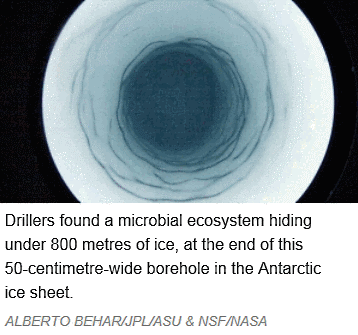|
|
|
|
|
|
|
News & Views item - February 2013 |
![]() Life Found in Antarctic Subglacial Lake. (February 12, 2013)
Life Found in Antarctic Subglacial Lake. (February 12, 2013)
 John
Priscu, Professor of Ecology in the Department of Land Resources
and Environmental Sciences at Montana State University is a principal
investigator in the McMurdo Dry Valleys Long Term Ecological Research (LTER)
project. Yesterday, having just returned from Antarctica, he spoke with
Nature's Quirin Schiermeier: “Lake
Whillans (83°40′S 145°00′W) definitely harbours life. It appears
that there lies a large wetland ecosystem under Antarctica’s ice sheet, with an
active microbiology.” It measures 60 square kilometres, on average is a shallow
two metres and sits 0.8 km below the surface of the Ross ice shelf.
John
Priscu, Professor of Ecology in the Department of Land Resources
and Environmental Sciences at Montana State University is a principal
investigator in the McMurdo Dry Valleys Long Term Ecological Research (LTER)
project. Yesterday, having just returned from Antarctica, he spoke with
Nature's Quirin Schiermeier: “Lake
Whillans (83°40′S 145°00′W) definitely harbours life. It appears
that there lies a large wetland ecosystem under Antarctica’s ice sheet, with an
active microbiology.” It measures 60 square kilometres, on average is a shallow
two metres and sits 0.8 km below the surface of the Ross ice shelf.
Since January 28 when Professor Priscu's team broke through, they have collected 30 litres of water as well as eight 60cm long sediment cores from the lake's bottom.
Nature reports that both "water and sediment contain an array of microbes that did not need sunlight to survive. The scientists counted about 1,000 bacteria per millilitre of lake water — roughly one-tenth the abundance of microbes in the oceans". Of course now begins critical molecular analyses of the samples' microbiology -- Professor Priscu notes that the cultured samples show excellent growth rates and it will take at least a month just to get the basic work done: "What we are all dying to find out now is, of course, ‘who’s there’ and ‘what’s their life style'. So for example if Jupiter’s moon Europa, hosts a large sub-surface watery ocean might it contain similar life forms where photosynthesis is an impossibility.
“We have been allowed a glimpse into Antarctica’s subglacial world,” Priscu says. “I’m sure our results will change the way we view that continent.”